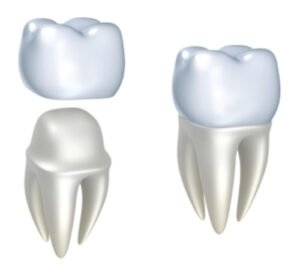 Crowns are an excellent way to repair teeth that have been broken, or have been weakened by decay or a very large filling. A crown could be made for a number of other reasons, for example:
Crowns are an excellent way to repair teeth that have been broken, or have been weakened by decay or a very large filling. A crown could be made for a number of other reasons, for example:
- you may have a discoloured filling and would like to improve the appearance of the tooth.
- you may have had a root filling and need a crown to protect what is left of the tooth.
- it may be the part of a bridge that is cemented to a natural tooth.
What Is a Crown Made Of?
Crowns can be made of a variety of different materials and new materials are continually being introduced. Some of the most popular options are listed below.
Porcelain Bonded to Precious Metal:
This is what most crowns used to be made from. A precious metal (gold alloy) base is made and then porcelain is applied in layers over it. These are not used as much in the mainstream because of the increasingly prohibitive cost of gold. In alternative dentistry that applies too. But there is another reason. Acupuncturists ask us to avoid the use metal, if possible, when repairing a tooth. They explain that all teeth exist on an acupuncture meridian and metal there blocks energy flow. That is a reason quite different from any suspected inherent toxicity of the metal itself.
Porcelain:
These crowns are made entirely out of porcelain and are not as strong as bonded crowns. But they can look very natural and are most often used for front teeth.
Zirconia :
Zirconia crowns and bridges are so strong they can be used anywhere in the mouth. Zirconia crowns can withstand the biting pressure of the front teeth as well as the much stronger forces that the back teeth apply to each other.
The look of zirconia crowns (and bridges) is so close to natural teeth that it is hard to tell the difference between them and natural teeth.
The Downside of Crowns
Crowns are invasive. Much of the tooth is cut away to provide space for the new outer layer that is the crown. A tooth requiring a crown has usually suffered trauma in the past from decay and fillings. All of this has threatened the pulp. The trauma of making a crown – heat and vibration despite our best efforts to minimize them – is added to the trauma of the past. That might cause the pulp to get inflamed. Inflammation implies swelling. Contained by the rigid tooth material, swelling can’t happen. So the internal pressure goes up instead. That might damage the pulp irreversibly.
If that happened, then the tooth would require root canal therapy to save it. If that is not an option, then the tooth would have to be removed.
Reducing the Downside?
With the patient’s consent, a Growing Beautiful Smiles, we take an additional step to attempt to prevent pulp damage from drilling on the tooth to prepare it for a crown. We want to send the message to the pulp “Don’t get inflamed – it’s not in your best interest.” There is a steroid drug called dexamethasone used as eye drops. The dosage suggested there is 1 or 2 drops every 6 hours.” We apply 1 or 2 drops once to the freshly prepared dentine surface because of evidence that this suppresses inflammation of the pulp without impairing its ability to repair itself.
Using pharmaceuticals* is not our favourite thing to do, but neither are root canal treatments.
* Except for local anesthetics (“freezing”) We use lots of them because we don’t like pain either. In both these instances the use is short term. For the most part prescription drugs cause all the problems they do with prolonged use.


